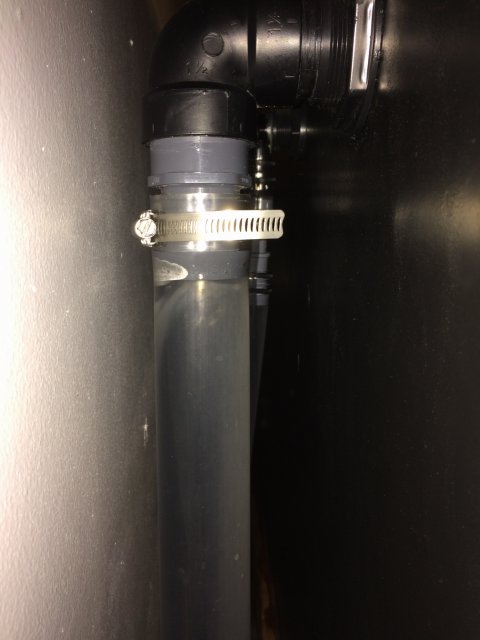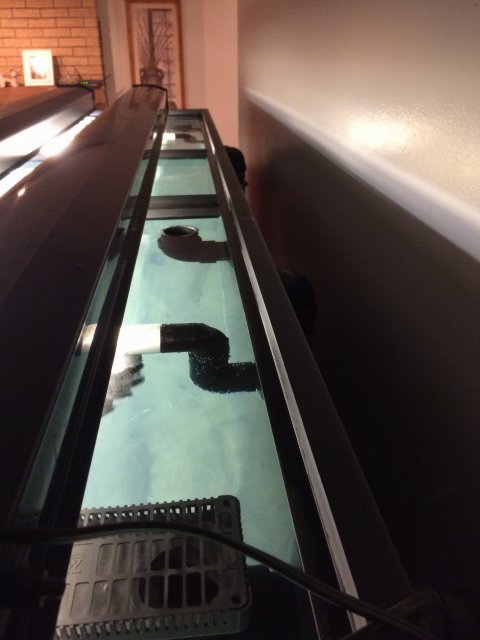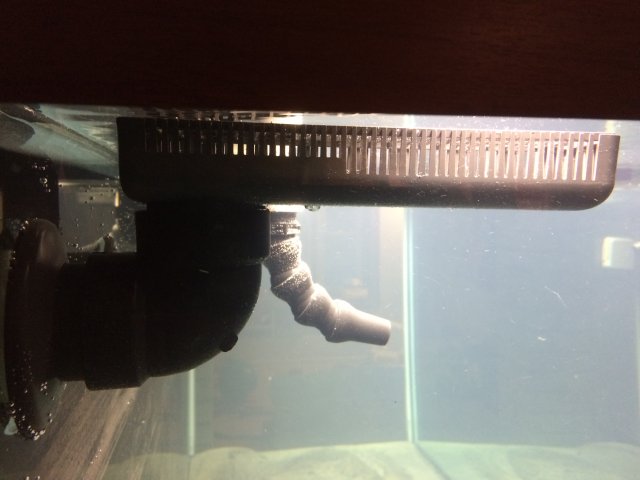I believe you'd need your main drain to be several inches (like 4"?) Below the water to create a full siphon and not suck air.
Need some help with noise reduction options
- Thread starter Fish Tank Travis
- Start date
You are using an out of date browser. It may not display this or other websites correctly.
You should upgrade or use an alternative browser.
You should upgrade or use an alternative browser.
This is basically what I'm going for. This guy just has one H2Overflow and an emergency drain but I will probably have two and then one emergency drain that will basically stay close to dry. He is running a single DCT 4000 which is rated for about 1050gph, where I'm running two Rio 20HF's at 1,200gph each. He has a bit less head height than me though so I would say that the flow per H2Overflow between his setup and mine should be somewhat close. I'm hoping so anyway.
You don't want to run full syphon with these h2o overflows. What I would do it make a stand pipe for the outside of the bulkhead with a tee and drill ha hope in the top for a 1/4inch air line. As for the sump I would bring both drain lines out of the water to stop the gurgling
Some good advice given. If you can't get your noise levels down to an acceptable level, and before you get rid if the tank, maybe consider removing the sump, covering the holes and adding canisters?
I have a two piece acrylic lid (.25") on my sump, which is where most of the noise comes from in my setup. I'd assume, since an acrylic lid reduced the noise I heard from my sump, it should reduce the noise you hear from the overflows.Yes, the three overflows and the 1.5" drain lines behind the tank are the source of 80-90% of the noise. The top is open right now, but I want to hear if you guys think adding a piece of .220" acrylic to cover the two open parts of the top will be effective in blocking the sound of the water draining into the overflows, or if you think it won't really do anything.
Also, the other main source of the sound seems to be the water hitting the sides of the 1.5" tubing on its way down behind the tank. The end of the tubing that flows into the sump is submerged inside the first chamber of the sump, so it's not that loud. However, do you guys think that adding some pipe foam insulation around the tubing running from the bulkhead to the first chamber of the sump will reduce much of this noise, or do you think it won't do much?
The last main option I was thinking about trying is to remove the H2Overflows and use pieces of different length PVC pipes to try to make some sort of bean animal type system. I would install a valve on the 1.5" line that has the shorter standpipe and throttle it back until it runs with a full siphon, and then just let the other two drains accept a trickle, but mainly act as emergency overflows. I'm not really wanting to try this option unless I have to because I am going to be keeping fire eels and I don't want them to be able to find their way into the overflow and end up in the sump, or worse, stuck in the valve that is creating the siphon.
I would like to hear what you all think about my ideas. Also, if you have any other ideas that I haven't mentioned, I'm all ears.
Well, I worked on it a good part of the day today and got some good results.
I installed 1.5" valves on all of the drain lines.

Then I adjusted, and adjusted, and adjusted the valves of two of the H2Overflow drains until I got them set up with a full siphon. The third is the emergency drain and the valve stays fully open.

I removed the middle H2Overflow and replaced it with a piece of abs pipe that stands a tiny bit higher than the H2Overflows on the sides. The water sits right at the edge of this pipe, but it actually stays dry.

As you can see in this last picture, the H2Overflows are actually full submerged by about an 1/8". They actually still skim the surface pretty well because there is a slight vortex over rear of the overflow that is just strong enough to capture and pull down surface debris. It's not anything like the way it used to be when all three H2Overflows were running gurgle style, but it's better than nothing, and it will keep my eels from getting in. In addition, I replaced all of the long street elbows with slightly shorter regular slip elbows. I did this because when I was first adjusting the valves to get it running the water level was pretty much maxed out in the tank.

So, by doing all of this, I got rid of the gurgling sound coming from the open top H2Overflows, the waterfall noise from the overflow lines behind the tank, and the bubbling noise from the submerged line ends in the first chamber of the sump. The whole tank is virtually silent now. The only sound coming from it is the hum from the pumps. I'm pretty excited that this all worked out. I also got the tops cut and laid on the top of the tank. Once I get a little decor inside I can move my fire eels over. I actually picked up a piece of 3" abs pipe and cut two 18" lengths to put in the tank real quick as temporary hiding places for them but guess what...abs floats! Who knew?! Lol. I don't want to put them in until they have some stuff to hide them.
I installed 1.5" valves on all of the drain lines.

Then I adjusted, and adjusted, and adjusted the valves of two of the H2Overflow drains until I got them set up with a full siphon. The third is the emergency drain and the valve stays fully open.

I removed the middle H2Overflow and replaced it with a piece of abs pipe that stands a tiny bit higher than the H2Overflows on the sides. The water sits right at the edge of this pipe, but it actually stays dry.

As you can see in this last picture, the H2Overflows are actually full submerged by about an 1/8". They actually still skim the surface pretty well because there is a slight vortex over rear of the overflow that is just strong enough to capture and pull down surface debris. It's not anything like the way it used to be when all three H2Overflows were running gurgle style, but it's better than nothing, and it will keep my eels from getting in. In addition, I replaced all of the long street elbows with slightly shorter regular slip elbows. I did this because when I was first adjusting the valves to get it running the water level was pretty much maxed out in the tank.

So, by doing all of this, I got rid of the gurgling sound coming from the open top H2Overflows, the waterfall noise from the overflow lines behind the tank, and the bubbling noise from the submerged line ends in the first chamber of the sump. The whole tank is virtually silent now. The only sound coming from it is the hum from the pumps. I'm pretty excited that this all worked out. I also got the tops cut and laid on the top of the tank. Once I get a little decor inside I can move my fire eels over. I actually picked up a piece of 3" abs pipe and cut two 18" lengths to put in the tank real quick as temporary hiding places for them but guess what...abs floats! Who knew?! Lol. I don't want to put them in until they have some stuff to hide them.
Now, I think I'm going to look into some poret foam to replace the crappy floss I got off of Amazon. I'm thinking a 3" piece of 20ppi sitting on top of a 3" piece of 30ppi, and then a 1.5" piece of 45ppi that I can throw in temporarily to polish the water.
Good jobon the fix.
Inwoukd just do all 20ppi the 20 is ok but feel like the 30 ppi through out will give you better results with out having to mess with 45.
Are filter socks an option ? You can make sock holders out of egg crate/lighting panel from lowes and just sit them on your bio.
Inwoukd just do all 20ppi the 20 is ok but feel like the 30 ppi through out will give you better results with out having to mess with 45.
Are filter socks an option ? You can make sock holders out of egg crate/lighting panel from lowes and just sit them on your bio.
Hi,
i would never connect the pumps with the plumbing directly.
I always put a sponge under the pump that it doesnt stand directly on the glas and
put a little piece of super soft silicone hose between the pump and the plumping.
That is another way to get everything a little bit more quiet.
i would never connect the pumps with the plumbing directly.
I always put a sponge under the pump that it doesnt stand directly on the glas and
put a little piece of super soft silicone hose between the pump and the plumping.
That is another way to get everything a little bit more quiet.
Nice job with all the tweaks, and glad it's quieter. I think at one point you were concerned about the eels getting stuck, and perhaps a low profile strainer?
I find that acrylic eventually starts to bend with heat from lighting and what not, but doesnt look like you have a need for lids now. I wanted to cover my internal overflow as well and used marine board. They have various thickness and can cut to size.
I find that acrylic eventually starts to bend with heat from lighting and what not, but doesnt look like you have a need for lids now. I wanted to cover my internal overflow as well and used marine board. They have various thickness and can cut to size.


